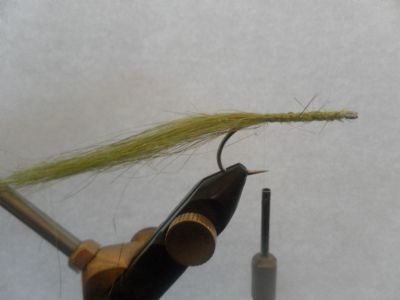Predator fly angler, bass fanatic and lure tying expert Dave Lindsay begins a saltwater lure tying series on Planet Sea Fishing. Over the coming months he will identify and discuss some deadly patterns before demonstrating exactly how to make them. He begins with how to tie a highly effective sandeel fly which is deadly for bass, pollack and mackerel among others.
 The natural sandeel is a hugely effective bait for saltwater fish across Europe, the Mediterranean and the Baltic. Sandeel is the staple prey for popular sport species such as sea trout, bass, mackerel, garfish and pollack. Fished alive or dead, it is one of the most widely used baits by both shore and boat anglers. Saltwater fly anglers know the pulling power of sandeels and few would venture out without a few sandeel mimics in their lure repertoire. Here I am going to take you through how to tie a perfect sandeel imitation that is irresistable to a host of sea fish, but bass and pollack in particular.
The natural sandeel is a hugely effective bait for saltwater fish across Europe, the Mediterranean and the Baltic. Sandeel is the staple prey for popular sport species such as sea trout, bass, mackerel, garfish and pollack. Fished alive or dead, it is one of the most widely used baits by both shore and boat anglers. Saltwater fly anglers know the pulling power of sandeels and few would venture out without a few sandeel mimics in their lure repertoire. Here I am going to take you through how to tie a perfect sandeel imitation that is irresistable to a host of sea fish, but bass and pollack in particular.
Basic Materials Required
- Piketrek 3/0 Heavy Duty fly hooks
- Clear mono thread
- EP Sparkle Brush bright Mylar
- Superhair filaments in yellow and olive
- Deer Creek Gator Eyes
- Piketrek MR Bond UV Resin
- UHU Glue
- Sharpie pen.

Lay down a bed of clear mono thread… start at the eye and wind back to the start of the hook bend and then return back to the hook eye.

Place a thin smear of the glue along the hook shank, this will secure the tying materials and prevent them from spinning around the shank.

Tie in at the head a five inch section of EP Sparkle – or another flash of your choice – and secure with a couple of thread wraps.

By now the glue will be tacky to the touch, so bring your thread down the shank until level with the point of the hook, then bring your thread back up to the eye.

Turn the hook upside down in the vice and take a five-inch long, thin section of yellow Superhair (I like to use Superhair or similar stiff fibre material as this gives a superb, solid, baitfish appearance in the water). This piece of material should be thin enough to be almost transparent. Offer this up to the shank at the eye and tie this first piece of yellow Superhair, securing it only as far back on the shank as shown above.

Select a second thin section of the yellow Superhair, slightly shorter than the first as will help give shape to the tail. Tie this in as above.

Flip the hook back upright and repeat steps 5 and 6 using thin sections of the olive Superhair tying off with a few thread wraps. Having tied in the olive and yellow hair the characteristic shape of the sandeel should now be apparent. By using the Superhair sparsely the nose shape is nicely formed.

By using the Superhair sparsely the nose shape is nicely formed.

If I’m using synthetic materials like to heat the hook eye slightly to melt the core under the nose. This not only helps the shape, but also forms a very secure bond to the hook as it melts internally.

A small Gator Eye is then placed into position on either side of the head. Gator Eyes are very tacky on the back and sit well while you get the positioning correct. Eye choice is completely up to you… 3D, stick-on or epoxy eyes can be just as effective.

With the tail colouring completed the sandeel is just about complete, all that is left to do is apply the epoxy head. I favour Piketrek’s Mr Bond Quick Cure UV to form the head, adding add a couple of layers to get the correct shape.

The cost of the initial purchase of the curing light is negligable if you are serious about fly/lure tying. Alternatively, normal epoxy can be used, but I find that layers of the UV version add weight to the fly helping the action in the water.
For more details on predator and saltwater fly tying, and information on how to purchase Dave’s quality work visit his website.
